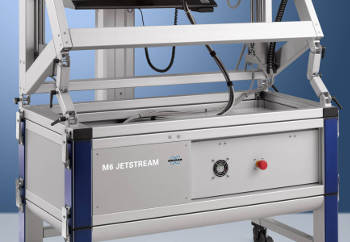At Analytica 2014, Bruker today introduces the M6 JETSTREAM™, a unique large format scanning micro X-ray fluorescence (Micro-XRF) spectrometer.
Providing a scan range of up to 800 x 600 mm2 and a scanning speed of up to 100 mm/s, the M6 JETSTREAM is designed to analyze the chemical composition of very large objects on-site in a single run with spatial resolution between 50 and 1,200 µm.
 The M6 JETSTREAM Micro-XRF Scanner
The M6 JETSTREAM Micro-XRF Scanner
With the introduction of this new high performance Micro-XRF analyzer Bruker is now serving a previously unaddressed demand from various application fields including QA/QC in automotive, aerospace and other industries, geological survey for natural resources, as well as art and conservation.
The Micro-XRF measuring head of the M6 JETSTREAM features a low power micro-focus X-ray tube in combination with a software controlled primary filter changer and focusing poly-capillary X-ray optics for sample excitation, and a high-resolution XFlash® silicon drift detector for acquisition of the fluorescence signal.
An integrated dual video microscope system provides images of the sample surface with two different magnifications – lower magnification for overview and orientation, higher magnification for final spot positioning in case of single point analyses.
The measuring head is mounted on a motorized, software controlled crossbar system which enables high-speed travel in X and Y direction with position reproducibility of 50 µm. An additional Z drive provides for video supported adjustment of working distance and spot size. The entire frame is tiltable, hence the measurement plane can be adjusted to any angle between the vertical and horizontal position.
The M6 JETSTREAM runs Bruker’s proven ESPRIT software suite, offering an easy-to-use graphical user interface and a wide range of functions for instrument control and data acquisition, as well as for qualitative and quantitative spectrum analysis. When performing line or area scans, complete spectra are stored in hyper-spectral databases so that chemical element or phase distribution analyses can be done at any time during or after the data acquisition.
Prof. Joris Dik, Antoni von Leeuwenhoek Chair, Dept. of Materials Science and Engineering, Delft University of Technology, user of an M6 JETSTREAM prototype and involved in the development of the instrument, told us: “This new instrument is a real asset to the world of museums and research on historical oil paintings. Its robustness and mobility allow measurements on site in the museum. The imaging capabilities of the instrument are a big advantage. Their application already led to a multitude of new insights on the origin and the conservation of cultural artifacts in general.”
Thomas Schuelein, President of Bruker’s Nano Analytics Division added: “With the introduction of the new M6 JETSTREAM we are responding to the long-standing need in various fields of research and industry to use the powerful and non-destructive Micro-XRF technique for on-site analyses of large scale objects. Developed in close collaboration with experienced researchers from Delft Technical University and the University of Antwerp, the M6 JETSTREAM is a solution that combines mobility and ease of use with high precision and unmet productivity.”
About Bruker Corporation
Bruker Corporation (NASDAQ: BRKR) is a leading provider of high-performance scientific instruments and solutions for molecular and materials research, as well as for industrial and applied analysis.
For more information, please visit www.bruker.com.